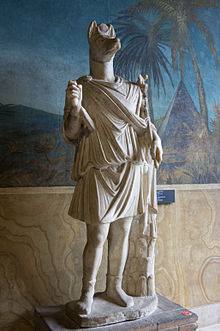Hermanubis

| Part of a series on |
| Ancient Egyptian religion |
|---|
 |
|
|
| Part of a series on |
| Ancient Greek religion |
|---|
 |
Hermanubis (Ancient Greek: Ἑρμανοῦβις, romanized: Hermanoubis) is a Graeco-Egyptian god who conducts the souls of the dead to the underworld. He is a syncretism of Hermes from Greek mythology and Anubis from Egyptian mythology. Hermanubis was one of the ancestors of the dog-headed Saint Christopher – a cynocephalus saint, who was, similarly to Anubis / Hermanubis, a powerful ferryman for travelers. [2]
Description
[edit]
Hermes' and Anubis's similar responsibilities (they were both conductors of souls) led to the god Hermanubis. He was popular during the period of Roman domination over Egypt.[3] Depicted having a human body and a jackal head, with the sacred caduceus that belonged to the Greek god Hermes, he represented the Egyptian priesthood. He engaged in the investigation of truth.[4][5][6]
The divine name Ἑρμανοῦβις (Hermanoubis) is known from a handful of epigraphic and literary sources, mostly of the Roman period. Plutarch cites the name as a designation of Anubis in his underworldly aspect, while Porphyry refers to Hermanubis as σύνθετος (sýnthetos) "composite" and μιξέλλην (mixéllin) "half-Greek".[7][8]
Although it was not common in traditional Greek religion to combine the names of two gods in this manner, the double determination of Hermanubis has some formal parallels in the earlier period. The most obvious is the god Hermaphroditus, attested from the fourth century BC onwards, but his name implies the paradoxical union of two different gods (Hermes and Aphrodite) rather than an assimilation in the manner of Hermanubis.[9]
See also
[edit]References
[edit]- ^ Statue of the god Anubis, Vatican Museums
- ^ Stefanovic, Danijela. "The "Christianisation" of Hermanubis, Historia 4, 2013, 506-5014". Journal of Ancient History. 62.
- ^ Smith, William (1878). A New Classical Dictionary of Greek and Roman Biography Mythology and Geography Partly Based Upon the Dictionary of Greek and Roman Biography and Mythology. Harper. p. 72.
- ^ Plutarch, De Iside et Osiride 61
- ^ Diodorus, Bibliotheca historica i.18, 87
- ^ Peck, Harry Thurston (1897). Harper's Dictionary of Classical Literature and Antiquities. Harper. p. 799.
- ^ Porphyry, De imaginibus fr. 8, p. 18. 1–2 Bidez
- ^ Budge, Sir Ernest Alfred Wallis (1904). The Gods of the Egyptians: Or, Studies in Egyptian Mythology. Methuen & Company. p. 493.
- ^ Benaissa, Amin (2010). "The Onomastic Evidence for the God Hermanubis". The Proceedings of the 25th International Congress of Papyrology. 25 (1). hdl:2027/spo.7523866.0025.116.
Bibliography
[edit]- A history of Egypt Under Roman Rule by Joseph Grafton Milne (1992) p. 195
- Who's Who in Egyptian Mythology by Anthony S. Mercatante (2002) p. 56
External links
[edit]- Statue of Hermanubis (Alexandria, early 2nd century CE) Archived 2015-02-17 at the Wayback Machine, Antiquities Museum of Bibliotheca Alexandrina
